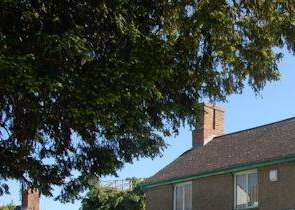I happened to be in the churchyard at Castle Caereinion not long ago, and was mystified by a sharp tapping noise coming from a large yew tree near the south-east gate. I walked quietly up to the tree; several birds flew off as I approached, but the tapping continued. I had thought woodpecker at first, but this tapping, though very definite and distinct, was I think not loud enough; this was a smaller bird.
In fact, the number of birds in this large and spreading and quite ancient tree was huge, as many as I’ve ever seen in a tree this size. On top were a dozen jackdaws, part of a flock that had flown in and settled in various places round about. A pair of collared doves appeared, invisible until they flew off. The village house sparrows were coming and going, with lots of blue tits, great tits and miscellaneous finches.
The yew is probably the most long-lived of our native trees. Unusually for a conifer, its seeds are borne not in cones but in red berries (or, more precisely, in fleshy berry-like structures called arils). These berries are popular with birds like thrushes and blackbirds. The seeds are excreted, an effective dispersal mechanism much needed as yew seeds will not germinate well, if at all, beneath the parent tree.
Yew berries are also taken by squirrels and dormice, and the fleshy part (the aril) is quite good eating. The seed itself, however, or more precisely its coating, contains toxic alkaloids, as do the leaves, which growers may harvest and sell as the taxane alkaloid is the active ingredient of an effective cancer drug. Not all yew trees have berries - yews are dioecious, bearing male and female flowers on separate trees.
One possible source of the tapping I heard could have been a nuthatch, particularly since I spotted at least one among the birds flying from the tree. Nuthatches do take yew berries; more to the point, they often place nuts and seeds in crevices in order to hammer them open with their sharp beaks, and the trunk and branches of an old yew will supply many such cracks and openings. The soft bark also attracts tree creepers, who probe for insects as they creep, mouselike, up and around the trunk and branches. The yew’s thick canopy is good shelter, which helps explain the sheer number of birds there were in the one in Castle churchyard that day. Yews are noted as giving shelter and nest sites for our two smallest birds, the goldcrest and firecrest.
No-one seems very sure why yew trees are planted in churchyards, but being very long-lived they have been seen as symbols of immortality. They may also have been planted over the graves of plague victims to purify the soil. But there are many church-yards that contain yews older than the church, and this is a tree that was regarded as sacred before Christianity reached our shores.
Part of the yew canopy, and the roof of Mike Rogers' shop

No comments:
Post a Comment